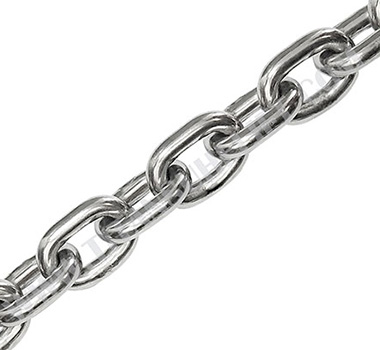Types of Heavy Duty Stainless Steel Chain

02
DIN766 Stainless Steel Link Chain
The chain welding joints are fully welded without burrs, which is firm and not easy to break after long-term working. It's superior properties are strong bearing capacity, waterproof and rustproof.

03
ASTM80 Stainless Steel Link Chains
Titansuhe produces various chains including stainless steel chains, lifting chains, mining chains and so on. All chains are calibrated and tested before delivery.

04
ASTM90 Stainless Steel Link Chains
These stainless steel chain manufacturing standards refer to ASTM 80, NACM 84/90, and NACM 96. Its quality class reaches G43. The minimum safety factor of the G43 chain is 2 times the working load.
Choose a Heavy Duty Stainless Steel Chain Bulk Factory
Titansuhe, one of the top stainless steel rigging manufacturers, has about 20-year-lifting experience of G80 chains, stainless steel chains and chain components. Our products are widely applied in industrial filed. Stainless steel chain materials are rust resistance and corrosion resistance, it's one of the best solution for oil and gas, offshore and chemical fabrication. No matter how complex or large in size you need, contact us for details.
Is galvanized chain better than stainless steel?
The galvanized chain has its surface treated with a layer of zinc. Zinc coating protects the chain body from rust. Galvanized chains do not degrade too much when exposed to the water. Heavy duty stainless steel chain are very strong and resistant to rust when contacting with water or salt water, etc. However, welding stainless steel requires professional skills. During the heating and cooling of stainless steel, the welder must practice more to achieve sophisticated welding.
In general, galvanized chains are more malleable and easier to work with than heavy duty stainless steel chains. Stainless steel chains are stronger and more corrosion resistant than galvanized chains. Galvanized chains cost less than stainless steel.
How strong is stainless steel chain?
Stainless steel is distinguished by its bright surface, easy to clean, and can prevent corrosion and rust. Be obtained with such properties are the reason of the chromium element of the heavy duty stainless steel chains, the addition of chromium element makes the product surface form a layer of oxide.
For strength of stainless steel, it can add carbon, silicon, manganese or nickel to increase the strength of the stainless steel chain.
Common stainless steel chain materials are AISI304, AISI316 and AISI316L
Heavy duty stainless steel chains is the strongest material compared with other chains. Because the forging process requires experienced skills and more material, its cost is relatively high.
What is The Difference Between MaterialAISI304, AISI316 and AISI316L
304 stainless steel is the most common steel. As a widely used steel, it has good corrosion resistance, heat resistance, low temperature strength and mechanical properties; Stamping, bending and other hot workability is good, and there is no heat treatment hardening phenomenon (non-magnetic, convenient use temperature - 196 ℃ ~ 800 ℃).
316 stainless steel has excellent corrosion resistance, atmospheric corrosion resistance and high temperature strength due to the addition of molybdenum, so it can be used under harsh conditions; Excellent work hardening (non-magnetic).
Scope of application: seawater equipment, chemical, dye, papermaking, oxalic acid, fertilizer and other production equipment; Photography, food industry, coastal facilities, ropes, CD rods, bolts, nuts.
316L stainless steel (L is low carbon) as a low-carbon series of 316 steel, in addition to the same characteristics as 316 steel, it has excellent grain boundary corrosion resistance.
Scope of application: products with special requirements for grain boundary corrosion resistance.










































